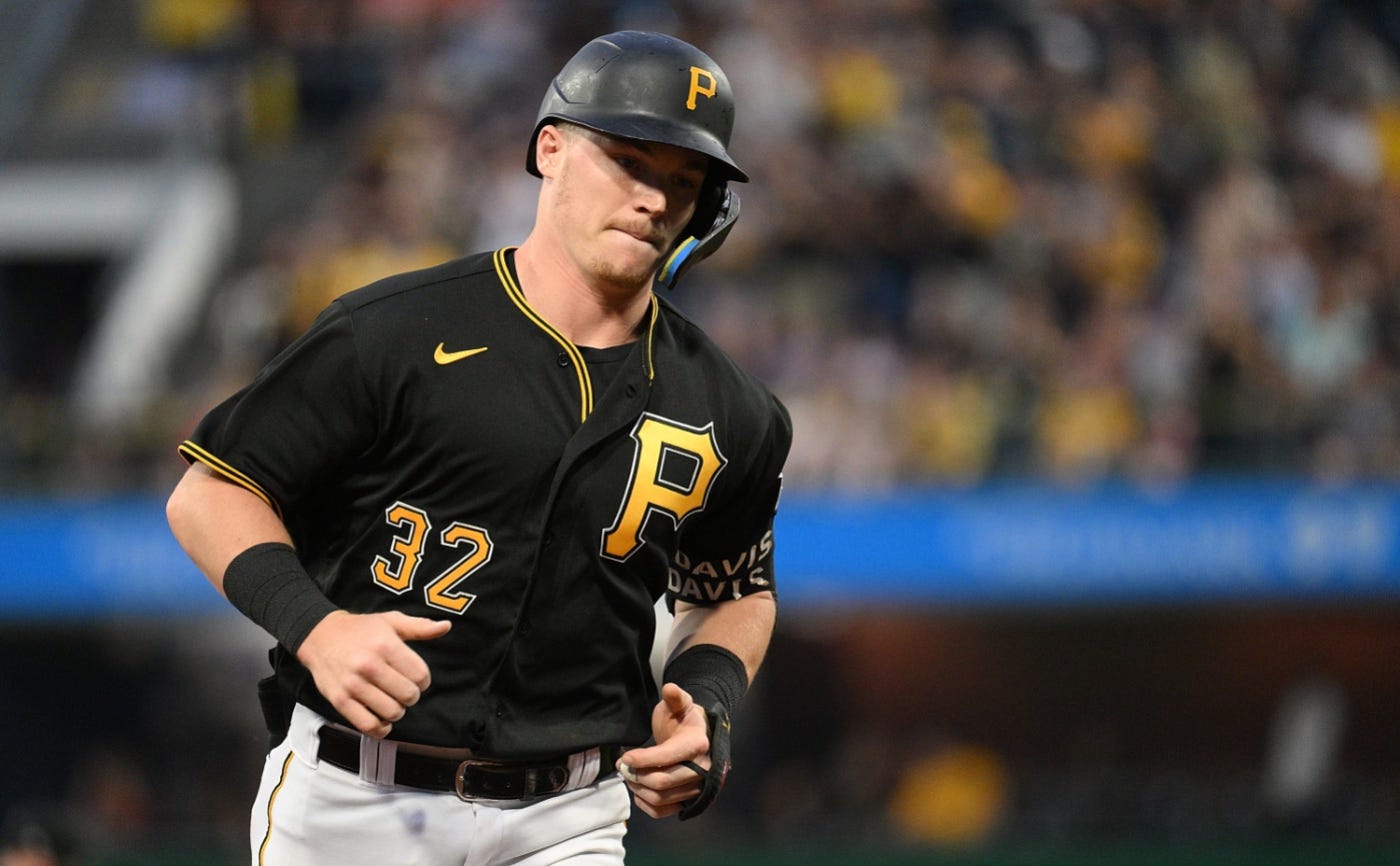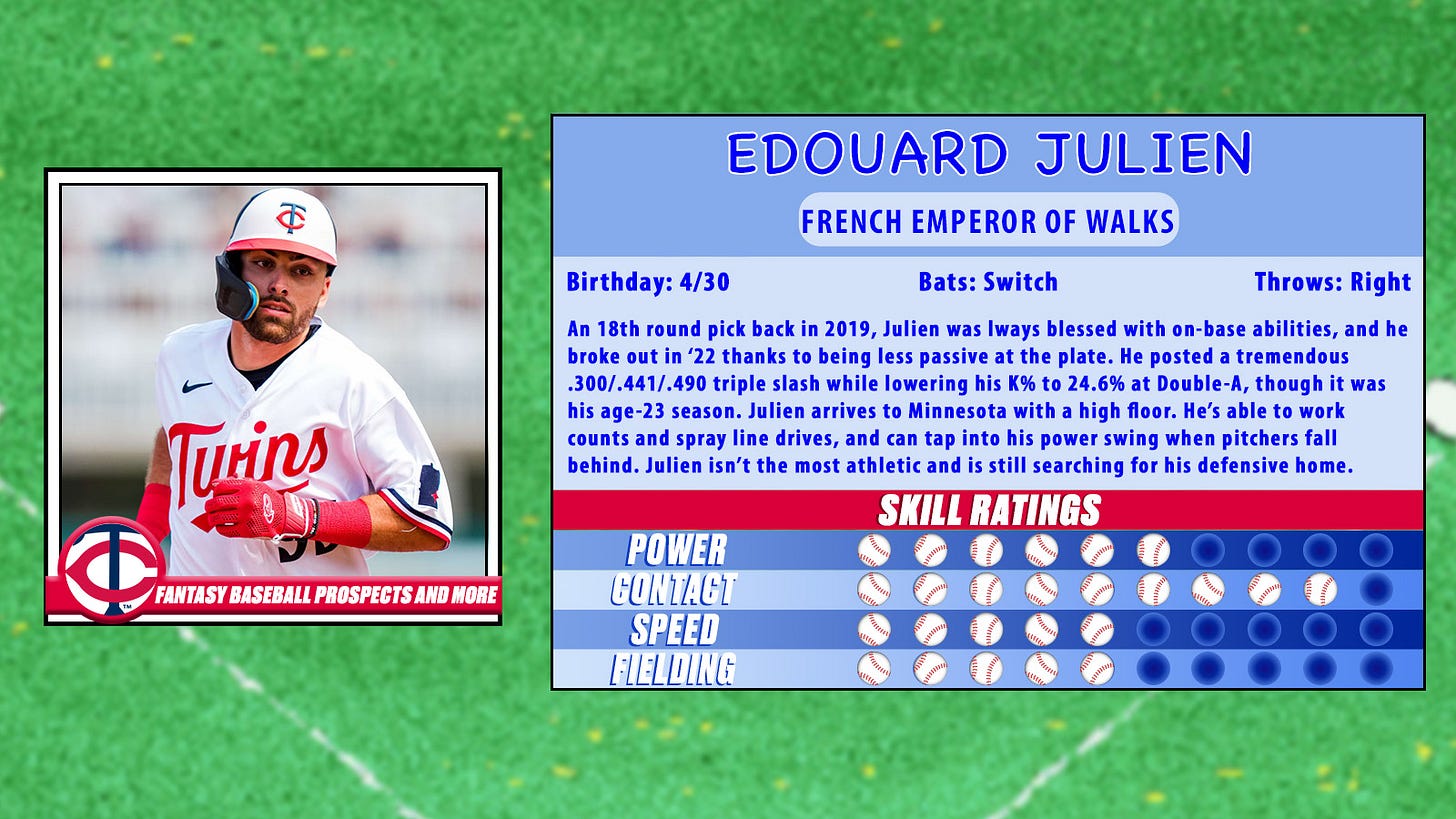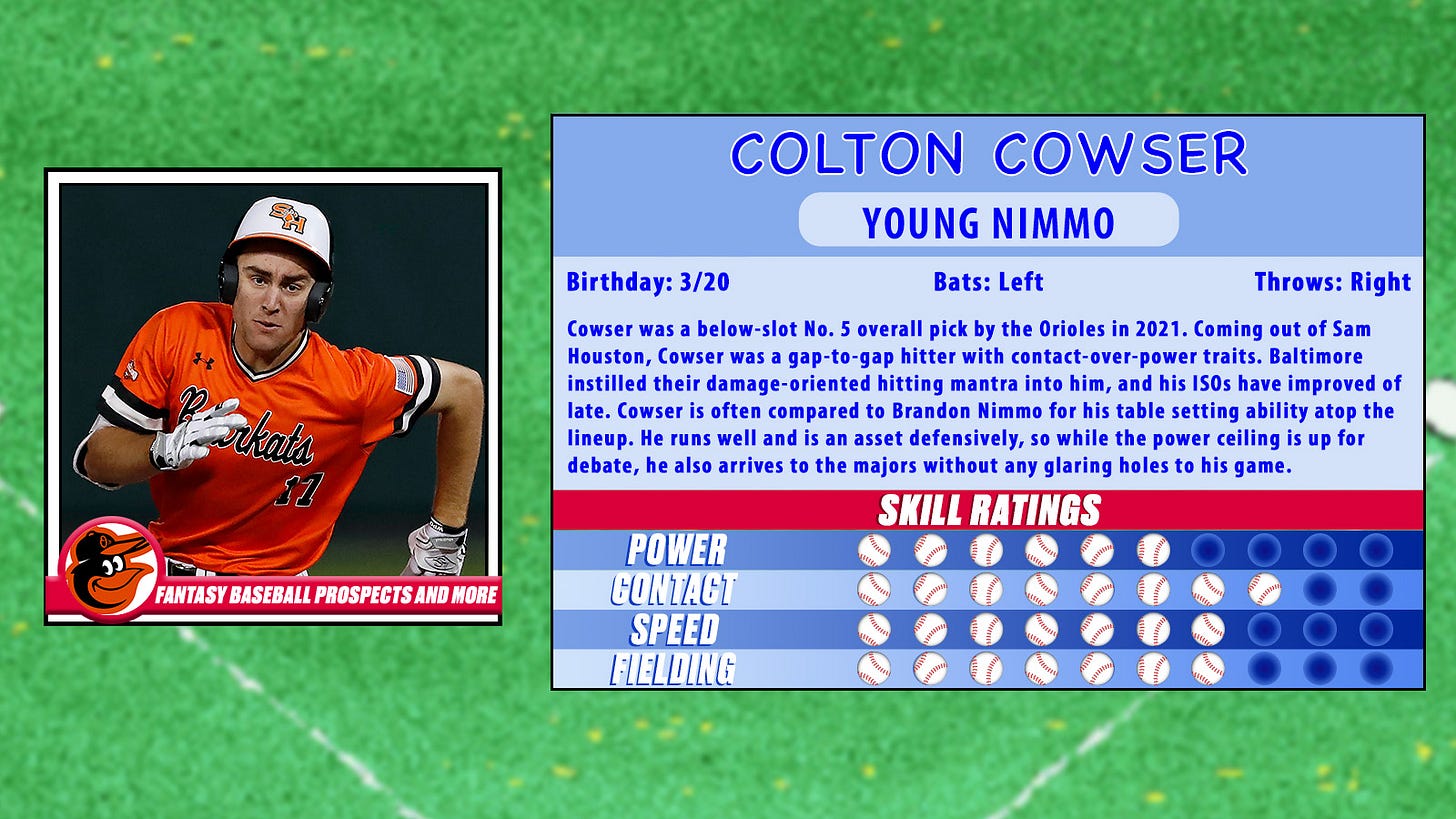Small Sample Rookie Hitter Analysis
Looking at the underlying stats of some Summer call-ups
The goal of this piece is to take a look under the hood at what several rookie hitters are doing in small samples. Of course, it should be noted that young players are volatile in fantasy baseball - we have less data on them and therefore don’t always know the true baseline. It’s part of what makes the recent Josh Lowe downturn so disappointing. Things looked great early on, but a larger sample exposed the extent of the flaws.
However, there are still things to be learned early on. Looking at the swing decisions and batted ball data (as opposed to just surface level numbers) helped Patreon subscribers be early on the Gunnar Henderson breakout, in addition to (hopefully) selling high on James Outman, among other observations.
As always, reach out on Twitter @toomuchtuma with questions. Note that I’ll always respond more quickly on Patreon (which includes a Discord invite!)
Henry Davis, C/OF, Pirates
There’s a full-on youth movement occurring in Pittsburgh. After breaking in Oneil Cruz to the majors last summer, the Pirates have recently called up Davis, Nick Gonzales, Endy Rodriguez, and Quinn Priester. There’s also more help on the way with the eventual arrivals of Termarr Johnson and Paul Skenes.
But we’re focusing first on Davis, the club’s No. 1 overall pick from the 2021 amateur draft. Davis was an under-slot signing at the 1.01, but he progressed through the minors quickly and debuted in mid-June of this year. Thus far Davis has only started in the outfield, and it remains to be seen how much catching he does with Endy Rodriguez now on the roster too.
Davis is slashing .284/.381/.451 through 29 games. It adds up to a 129 wRC+ and comes with 4 homers and 3 stolen bases. For fantasy managers who have been starting him at the always-weak catcher position, this production has been tremendous.
Is it sustainable? A quick glance at his plate discipline looks promising — an 11% walk rate and an 18.6 K%. A 29.2% chase rate is perfectly fine, as is a 9.8% swinging strike rate. If there’s one area to nitpick it could be that Davis might benefitting from more in-zone swings, but it’s also hard to argue with the results so far.
As for his batted ball metrics, Davis is hitting grounders over 50% of the time. A .329 BABIP might be a tad lucky, though he checks in with a 75th percentile sprint speed, so he’s actually quick “for a catcher.”
Overall, I mostly buy this from Davis, especially when you factor in the ability to get these stats from a catcher. On sites where he maintains that eligibility this offseason, I think he’ll wind up as an attractive backstop for 2024 roto leagues.
Jordan Westburg, 2B/3B, Orioles
It’s important to note we haven’t seen Westburg fully unlocked as an everyday player yet:
And as expected, they’re moving him around the infield with 8 starts thus far at 2B and 7 coming at 3B. I’d expect the playing time logjam to get resolved somewhat after the trade deadline, though Baltimore still has more prospects on the way and I’m beginning to view them more and more like the Rays as it pertains to platoons.
After beginning his career with 5 hits in his first 3 starts, Westburg hasn’t done all that much in July. Overall he’s hitting .262/.318/.393 (good for a 97 wRC+ and 1 stolen base).
He hasn’t homered yet, and that’s the number one reason I’d be willing to sell him in dynasty leagues. I’m essentially “out” on any right-handed Orioles hitters. The left field wall is just too disastrous. It’s been a clear issue for Ryan Mountcastle, who has massively under performed his expected stats since the fences were pushed back. Mounty popped 22 homers last season, but he could’ve had 30+ elsewhere, according to Statcast’s “expected homers by park” metric.
Westburg isn’t overly “swing happy”, but he swings (and chases) more often than average. That’s fine since he has a good hit tool, and he pulls a ton of fly balls, which I love.
But he’s pulling them directly into “Walltimore.” If Westburg played on the Reds I could see him being valued similarly to Spencer Steer eventually. However, he’s a fantasy fade for me while he remains in the Orioles’ organization.
Nick Gonzales, 2B/SS, Pirates
Gonzales was a borderline top-10 dynasty prospect after a tremendous 2021 campaign at High-A. Unfortunately, he didn’t immediately live up to expectations in 2022, and his prospect shine wore off prior to this summer’s big league call-up.
The 24-year-old middle infielder enters Monday slashing .244/.290/.407 in 93 PAs. After walking 12.4% of the time in his minor league career, Gonzales has just a 3.2 BB% with the Pirates so far.
He isn’t chasing, but he’s whiffing at an alarming rate. His 17.6% swinging strike rate would be the third highest among qualified hitters right now. To be fair the two players above him are Nick Castellanos and Luis Robert, but Gonzales is unlikely to do as much damage on batted balls than them. It’s also worth noting a high SwStr% was an issue of his in the minors too.
Gonzales’ .163 ISO isn’t disastrous, though. This isn’t a full-on slap hitter profile. The issue is that Gonzales has a 59.7% grounder rate, and the fly balls he’s hitting are going to the opposite field 50% of the time. This is a similar issue to what Ke’Bryan Hayes has gone through during the early portion of his career.
It feels as if Gonzales is stuck between fully selling out for power and trying to make as much contact as possible. Despite entering pro ball as an accomplished college bat with an innate hitting ability, Gonzales’ natural inside-out swing isn’t optimized for fantasy production. He has paths to usefulness down the road, but I’d only consider him as a throw-in for dynasty trades right now.
Edouard Julien, 2B, Twins
Earlier this week it became apparent that Julien was one of the hottest hitters in the majors. When this happens the play is always “add now, figure it out later.”
The time has come to evaluate Julien’s .307/.388/.540 triple slash line. It adds up to a 158 wRC+, which is the highest mark among rookie bats this season.
But Julien has been even better since his most recent promotion from Triple-A on June 10th. Since then he has a 187 wRC+, to go along with a .358 AVG and 5 homers. This has come with an absurd .508 BABIP, so regression is obviously coming.
The question is where Julien’s baseline settles at. He’s currently running a 32.3 K% and an 11.6 BB%, which is a bit more exaggerated than his minor league rates. Julien’s 19.3% chase rate would be the 3rd lowest in MLB if he had the PAs to qualify.
His swinging strike rate is average, but he’s taking so many called strikes, which reminds me a little of Gunnar Henderson’s issues earlier this season. Gunnar broke out by swinging more overall. Julien’s current profile suggests he’ll need to pick and choose his spots, which is a trait that should improve with experience.
It goes without saying that Julien carries more value in OBP leagues, but even then I’m worried about some incoming regression. We already mentioned the BABIP, but he also has a .540 SLG with a .452 xSLG. I’d be more alright with this if he was pulling at least 1/3 of his fly balls to overcome the weak expected stats, but as of this writing his pulled fly ball rate is just 20%.
Julien is a valuable player, of course, and everyone should ride the hot streak for as long as it lasts. But I’m not yet convinced he’ll be an every-week starter from here on out.
Luis Matos, OF, Giants
The biggest thing to keep in mind with Matos is that he’s just 21 years old, whereas everyone else we’ve discussed so far is already 24 (or about to turn 24 in Davis’ case).
Matos began the year in Double-A, and dominated. He moved to Triple-A and dominated even more, and now he’s in the bigs as the Giants’ primary center fielder.
Through 115 PAs Matos is slashing .257/.316/.333, good for an 82 wRC+. The biggest issue is that he’s hitting for virtually no power — his ISO stands at a paltry .076 mark.
Matos makes a ton of contact — his 84.6% rate would be top-20 among qualified bats. When looking at his in-zone and out-of-zone swing rates, I’m very impressed. The foundation is there to build on. Matos has underachieved somewhat in the power department, with a .411 xSLG. He just needs to improve his barrel rate and exit velocities. This should hopefully happen as he physically matures throughout his early 20s.
Zack Gelof, 2B, Athletics
Here we have another 23-year-old who has hit the ground running, posting a 150 wRC+ in an extremely small sample of 37 PAs in the majors.
What concerns me is a 17.1 SwStr%, which leads to a 29.7 K%. There’s an early tendency to expand the zone a bit, but nothing drastic. It’s also an extremely high fly ball rate so far, but again the sample is so small.
I won’t go much deeper into Gelof because of the limited number of at-bats, but the short takeaway is to not buy into the success he’s had thus far (though of course things could change as we get more data down the road, as noted in the intro to this piece).
Tyler Soderstrom, C/1B, Athletics
It’s only been 32 PAs for Soderstrom, and like Matos he’s just 21 years old. So we’re barely scratching the surface with the reps we’ve seen thus far.
The early returns show he might be a bit overmatched, led by a 66.7 GB% and a 15.7 SwStr%. The reason I mention the possibility of him being “overmatched” as a concern is he wasn’t dominating Triple-A (with just an 88 wRC+ in the PCL this season).
Soderstrom certainly isn’t on the redraft radar right now. He has serious power potential long-term, with “hitter-ish tendencies” in his tape, but his aggressiveness currently causes him to hit more “pitcher’s pitches” than necessary (something that goes hand-in-hand with his GB%). Perhaps more seasoning at Triple-A is in his short-term future.
Colton Cowser, OF, Orioles
We’ll close with another recent Triple-A call-up who is struggling early, but with Cowser I’m more confident the necessary changes will come quicker. The 23-year-old is hitting just .111 through 46 big league PAs, and he doesn’t yet have an extra-base hit.
The good news is he isn’t chasing, isn’t whiffing, and he has a 15.2 BB% with a 17.4 K%.
But he simply isn’t swinging. At all.
Cowser’s current 36.4 swing% would be the second lowest in baseball, behind just Juan Soto. And we saw earlier this year how tricky it was for Soto to find the right balance of when to swing.
Cowser is swinging even less than Julien, and his contact% is good/fine so there’s improvement to be made just from him getting more reps. And as a lefty bat on the Orioles I’m not worried about the park. He’s definitely more valuable in OBP formats, but I remain very “in” on Cowser for the short and long term.





